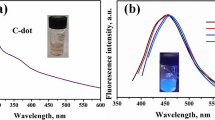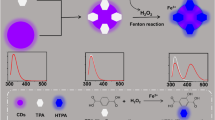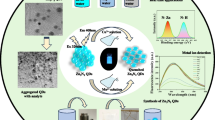Abstract
The significant fluorescence enhancement of CdSe/ZnS quantum dots (QDs) induced by Hg2+ was observed for the first time based on a CdSe/ZnS QD-modified fiber nanoprobe. The fluorescence enhancement mechanism contributed to the Zn-to-Hg cation exchange in the ZnS shell, which allowed to form a HgxZn1-xS/CdSe heterojunction and increase the separation of electrons and holes and reduce the recombination rate. High concentrations of Hg2+ accelerated the generation of the fluorescence signal and lead to higher fluorescence intensity. The maximum fluorescence intensity increased more than eight times when Hg2+ concentration was 1 µM. The characteristic time (θc), i.e., the rising time to achieve the maximum fluorescence intensity, was linearly dependent on initial concentration of Hg2+ solution in accordance with our proposed theory. When the evanescent wave optofluidic fluorescence platform was used, the linear detection range and detection limit of Hg2+ were 5.0–1000 nM and 0.80 nM, respectively. The fiber nanoprobe can be applied to the rapid, sensitive, and accurate on-site detection of Hg2+ in real water samples without significant matrix effect. Our work paves a novel way to develop a simple and reliable nanoprobe for mercuric pollution control, and achieve the high quantum efficiency of QDs by limiting the diffusion of Hg2+ in the ZnS shell.
Graphical abstract







Similar content being viewed by others
References
Michler P, Imamoglu A, Mason MD, Carson PJ, Buratto SK (2000) Quantum correlations among photons from a single quantum dot. Nature 406:968–970
Kahmann S, Shulga A, Loi MA (2020) Quantum dot light-emitting transistors—powerful research tools and their future applications. Adv Funct Mater 30:1904174
Mocatta D, Cohen G, Schattner J, Millo O, Rabani E, Banin U (2011) Heavily doped semiconductor nanocrystal quantum dots. Science 332:77–81
Smith AM, Nie S (2011) Bright and compact alloyed quantum dots with broadly tunable near-infrared absorption and fluorescence spectra through mercury cation exchange. J Am Chem Soc 133:24–26
Galle T, Kazes M, Hübner R, Lox J, Eychüller A (2019) Colloidal mercury-doped CdSe nanoplatelets with dual fluorescence. Chem Mater 31:5065–5074
Kroupa DM, Hughes BK, Miller EM, Moore DT, Anderson NC, Chernomordik BD, Nozik AJ, Beard MC (2017) Synthesis and spectroscopy of silver-doped PbSe quantum dots. J Am Chem Soc 139:10382–10394
Engel JH, Surendranath Y, Alivisatos AP (2012) Controlled chemical doping of semiconductor nanocrystals using redox buffers. J Am Chem Soc 134:13200–13203
Zhang Q, Leonardi F, Casalini S, Mas-Torrent M (2017) Mercury-mediated organic semiconductor surface doping monitored by electrolyte-gated field-effect transistors. Adv Funct Mater 27:10389
Morgan D, Kelley DF (2018) Role of surface states in silver-doped CdSe and CdSe/CdS quantum dots. J Phys Chem C 122:10627–10636
Izquierdo E, Dufour M, Chu A, Livache C, Martinez B, Amelot D, Patriarche G, Lequeux N, Lhuillier E, Ithurria S (2018) Coupled HgSe colloidal quantum wells through a tunable barrier: a strategy to uncouple optical and transport band gap. Chem Mater A Publ Am Chem Soc 30:4065–4072
Zhong X, Han M, Dong Z, White TJ, Knoll W (2003) Composition-tunable ZnxCd1-xSe nanocrystals with high luminescence and stability. J Am Chem Soc 125:8589–8594
Long F, Zhu A, Wang H (2014) Optofluidics-based DNA structure-competitive aptasensor for rapid on-site detection of lead(II) in an aquatic environment. Anal Chim Acta 849:43–49
Nath N (1998) Evanescent wave fiber optic fluorosensor: effect of tapering configuration on the signal acquisition. Opt Eng 37:220–228
Luan W, Yang H, Fan N, Tu ST (2008) Synthesis of efficiently green luminescent CdSe/ZnS nanocrystals via microfluidic reaction. Nanoscale Res Lett 3:134–139
Hines MA, Guyot-Sionnest P (1996) Synthesis and characterization of strongly luminescing ZnS-capped CdSe nanocrystals. J Phys Chem 100:468–471
Zeng T, Hu Y, Wang N, Xia C, Li S, Zu Y, Liu L, Yao Z, Zhao Y, Wu H (2013) Effects of different metal ions on the fluorescence of CdSe/ZnS quantum dots capped with various thiolate ligands. Phys Chem Chem Phys 15:18710–18715
Son DH, Hughes SM, Yin YD, Alivisatos AP (2004) Cation exchange reactions in ionic nanocrystals. Science 306:1009–1012
Trizio LD, Manna L (2016) Forging colloidal nanostructures via cation exchange reactions. Chem Rev 116:10852–10887
Qu Z, Yan L, Li L, Xu J, Liu M, Li Z, Yan N (2014) Ultraeffective ZnS nanocrystals sorbent for mercury(II) removal based on size-dependent cation exchange. ACS Appl Mater Interfaces 6:18026–18032
Patil RS, Gujar TP, Lokhande CD, Mane RS, Han SH (2007) Photoelectrochemical studies of chemically deposited nanocrystalline p-type HgS thin films. Sol Energy 81:648–652
Kershaw SV, Abdelazim NM, Zhao Y, Susha AS, Rogach AL (2017) Investigation of the exchange kinetics and surface recovery of CdxHg1-xTe quantum dots during cation exchange using a microfluidic flow reactor. Chem Mater 29:2576–2768
Gudjonsdottir S, Van Der Stam W, Kirkwood N, Evers WH, Houtepen AJ (2018) The role of dopant ions on charge injection and transport in electrochemically doped quantum dot films. J Am Chem Soc 140:6582–6590
Carey GH, Abdelhady AL, Ning Z, Thon SM, Bakr OM, Sargent EH (2015) Colloidal quantum dot solar cells. Chem Rev 115:12732–12763
Tian LJ, Min Y, Wang XM, Chen JJ, Yu HQ (2019) Biogenic quantum dots for sensitive, label-free detection of mercury ions. ACS Appl Bio Mater 2:2661–2667
Xie WY, Huang WT, Luo HQ, Li NB (2012) CTAB-capped Mn-doped ZnS quantum dots and label-free aptamer for room-temperature phosphorescence detection of mercury ions. Analyst 137:4651–4653
Jin LH, Han CS (2014) Ultrasensitive and selective fluorimetric detection of copper ions using thiosulfate-involved quantum dots. Anal Chem 86:7209–7213
Chen Y, Rosenzweig Z (2002) Luminescent CdS quantum dots as selective ion probes. Anal Chem 74:5132–5138
Li S, Cao W, Kumar A, Jin S, Zhao Y, Zhang C, Zou G, Wang P, Li F, Liang X (2014) Highly sensitive simultaneous detection of mercury and copper ions by ultrasmall fluorescent DNA-Ag nanoclusters. New J Chem 38:1546–1550
Sekowski JW, Malkas LH, Wei Y, Hickey RJ (1997) Mercuric ion inhibits the activity and fidelity of the human cell DNA synthesome. Toxicol Appl Pharmacol 145:268–276
Zhang Y, Xiao JY, Zhu Y, Tian LJ, Yu HQ (2020) A fluorescence sensor based on biosynthetic CdSe/CdS quantum dots and liposome carrier signal amplification for mercury detection. Anal Chem 92:3990–3997
Funding
This work was supported by the National Natural Science Foundation of China (21675171), and the National Key Scientific Instrument and Equipment Development Projects of China (2012YQ3011105).
Author information
Authors and Affiliations
Corresponding author
Ethics declarations
Conflict of interest
The authors declare that they have no competing interests.
Conflict of interest
The authors declare that they have no competing of interests.
Additional information
Publisher’s note
Springer Nature remains neutral with regard to jurisdictional claims in published maps and institutional affiliations.
Supplementary information
ESM 1
(DOCX 1174 kb)
Rights and permissions
About this article
Cite this article
Wang, H., Song, D., Zhou, Y. et al. Fluorescence enhancement of CdSe/ZnS quantum dots induced by mercury ions and its applications to the on-site sensitive detection of mercury ions. Microchim Acta 188, 215 (2021). https://doi.org/10.1007/s00604-021-04871-5
Received:
Accepted:
Published:
DOI: https://doi.org/10.1007/s00604-021-04871-5




